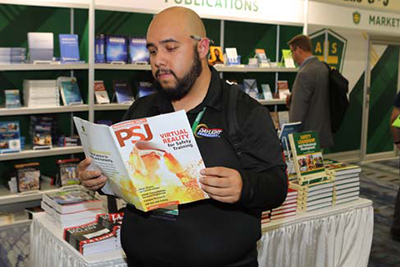
About Professional Safety
Professional Safety is ASSP’s flagship peer-reviewed journal and our top-ranked member benefit. Each monthly issue delivers
the latest technical knowledge in occupational safety and health (OSH) — developed through evidence-based information and on-the-job experience.
The journal
also publishes articles that describe industry best practices and share advances in consensus
standards developments.
Target Audience
Professional Safety articles aim to provide new information and best practices to OSH professionals. The more than 35,000
members who read the journal span a broad range of industries in the U.S. and around the globe.
Share Your Expertise
Call for Submissions
While the journal invites submissions on an ongoing basis, our Editorial Review Board encourages submissions to Professional Safety on a variety of specific topics of interest.
View the latest topics of interest
 Peer-Reviewed Manuscripts: Key Expectations
Peer-Reviewed Manuscripts: Key Expectations
ASSP’s Editorial Review Board evaluates the manuscripts ultimately published as peer-reviewed feature articles in the journal. As a
potential author, we encourage you to focus on these five areas when developing a manuscript for peer-reviewed feature
consideration:
- Topic: Professional Safety readership crosses a broad spectrum of experience and education. Focus on timely,
leading-edge topics. If you cover basic/fundamental topics, strive to advance and expand on information available
elsewhere.
- Depth: Cover your topic in sufficient depth. Draft an article that is not too narrow, broad or complex, keeping in
mind that ASSP membership covers the full career spectrum from students and young professionals to seasoned OSH leaders.
Strive for balance in your presentation rather than trying to oversell or denigrate any perspective. If your article is
targeting a particular audience (e.g., novice, experienced), please indicate that when submitting your manuscript.
- Timeliness: Include current statistics and reflect current accepted or emerging practices. While we ask that
references be relatively current, older references that offer historic perspective or are relevant to current practices
may remain appropriate.
- Purpose: Present information that adds to or advances the profession’s knowledge base. Avoid promoting or advertising
specific products, services or individuals as this detracts from the objectivity and credibility of the information
presented.
- Applicability: Present information and sound practices that are easily extractable and applicable. Provide practical takeaways, guidance or recommendations. Explain or show how safety professionals can apply the information in their own operations. Lessons
learned/how-to applicability is particularly relevant.
Submission Guidelines for Peer-Reviewed Manuscripts
Manuscripts submitted for publication must be original, must not be under consideration by another journal/publication, and must not have been previously published in any form (print, online, white paper, personal blog, social media, etc.). Carefully adhere to the following guidelines to submit a manuscript for review by the journal’s Editorial Review Board. Doing so
lends credibility to you as an author and supports your position as a qualified expert on your topic. Submit all documents
related to your manuscript to PSJ's editorial staff.
Word Count Guideline
- 2,500 to 6,000 words (preferred), not including illustrations
Format
- MS Word
- U.S. letter paper size
- Portrait orientation for all pages
- One-inch margins on all sides
- One text column: Do not use multiple columns
- 12-point font, preferably Times or other serif font
- Double-spaced with no additional space before/after paragraphs
- Number pages consecutively, including page 1, with a single numeral page number in the bottom right-hand corner.
- Apply continuous line numbers.
- Use 0.5-inch paragraph indents on body text.
- Ensure that subheading hierarchy is clearly indicated. PSJ can accommodate up to three tiers of subheadings.
- Insert tables and figures within the body text (not at the end of the article).
- Include no author identifiers in the main article (e.g., byline, headers/footers, bios) to help preserve the anonymous-peer-review process.
- Provide author contact and biographical information, including degrees held, granting institution(s) and designations held, in a separate document.
- Include a “Key Takeaways” summary consisting of two or three short, bulleted sentences that highlight what you will cover and what readers will learn
References
- Document all quotes, facts and figures according to APA style. Doing so lends credibility to the article and provides readers
with information to locate sources and conduct further research.
- Support statements and opinions with facts and viable references. Be sure to indicates when statements reflect your opinion as
the author and avoid overgeneralizations.
- Reflect the depth of information available on your topic via the references quoted/cited.
Graphics and Visual Content
- Figures and tables are not required, but add interest. Carefully chosen and well-prepared figures, such as diagrams and
photos, can greatly enhance an article.
- Strive to be sure these elements clarify and expand on key points or technical issues.
- Provide clear, easy-to-read, high-quality figures/charts/images for highest reproduction quality in print. Always provide captions and, if adapted from another source, credit the original publication.
- Illustrations (photos, graphs, charts) should be clear and concise, easy-to-read and self-explanatory, and they must be appropriately referenced if adapted from another source.
Author Agreement
Professional Safety authors must sign a transfer of copyright agreement, which assigns ASSP rights to the article but also
outlines author permissions for using the content.
Download the agreement
Peer-Review Process
The peer-review process typically takes at least 90 days. We will notify you to confirm that we have received your submission
and indicate whether it will be submitted to the Editorial Review Board. If selected for peer review, we will share with you
review comments and an indication of the submission’s status. The Editorial Review Board’s primary focus is to offer comments
that will improve your article and get it published.
If your article is accepted for publication, when submitting the revision, please:
- Highlight all changes made to manuscript (e.g., use the track changes feature in Word).
- Save charts, graphs, tables/figures or other electronically created images as separate files (not embedded files). Indicate
the software and version used, and include raw data for all graphs and charts so these items can be recreated to match journal
presentation style.
- Submit only high-resolution (300 dpi) digital photos. Acceptable formats include TIF, EPS and JPG.
- Send a copy of the final manuscript with changes highlighted and any graphics files to PSJ editorial staff.
- Submit a signed copyright agreement that allows PSJ to publish the article. The author retains the right to use the material
in other books, presentations, etc. Contact PSJ staff with any questions regarding this requirement.
I have some questions
Contribute Other Articles and News to Professional Safety
Professional Safety welcomes the submission of content in addition to peer-reviewed manuscripts — including event announcements, new product information and general news stories of interest to occupational safety and health professionals. Send your submissions to PSJ editorial staff for consideration.
- Best Practices Articles: Practical information, ideas and suggestions about safety improvements that readers can immediately apply in their workplaces and readily share with coworkers. (Suggested length: 1,800 to 2,500 words)
- Leading Thoughts Articles: General or safety-specific leadership guidance, advice or tips. (Suggested length: 1800 to 2,500 words)
- Training Tips Articles: Practical information and recommendations about delivering safety training. (Suggested length: 800 to 1,200 words)
- Checkpoints Articles: Discussion of the fundamentals of a specific safety practice. (Suggested length: 600 to 800 words)
- Vantage Point Articles: A forum for sharing ideas and opinions in order to encourage and stimulate critical thinking, discussion and debate on matters of concern to the OSH profession. (Suggested length: up to 1,800 words)
Tone and style for these articles: Most articles for the journal are written in the third person. In other words, authors do not speak directly to readers. Instead of using “you” statements (e.g., “You can . . .”) use universal language (e.g., “OSH managers can . . .”). In addition, these articles cannot promote a specific product, association or company. They should be informational – that is, they should be idea- and concept-focused rather than product- or company-focused.
Manuscripts submitted for publication must be original, must not be under consideration by another journal/publication, and must not have been previously published. When submitting these types of articles, please sign and submit a transfer of copyright agreement, which assigns ASSP rights to the article but also outlines author permissions for using the content.
Download author agreement
- Worth Reading Reviews: Reviews of current literature, book or other publication of interest to OSH professionals. Discuss the book within the context of personal experience. Interested in volunteering to review a book? Tell us your area of interest.
Download book review guidelines
- Reader Forum Letters: Reader commentary on stories, features and news reported in the journal.
- Event Announcements: Provide event date and location, sponsoring company and contact phone, e-mail and URL. Please send information at least three months in advance of the event.
- News Items: General news stories of interest to occupational safety and health professionals. These may be included in the Safety Matters section of the journal. Please include contact information for follow-up questions.
- Product Pulse Items: Submit a description of about 80-150 words that includes the company name and URL and the product name/model number; describes the product’s primary purpose, users and industries; and details the safety features and/or hazards it addresses. Include a high-resolution digital image (300 dpi at 2 to 3 inches wide; preferably showing the product in use or in a work setting) and contact information for follow-up questions. Submit materials to professionalsafety@assp.org.
Editorial Policy
Professional Safety reserves the right to edit all journal content to improve clarity and grammar, to adhere to journal style, and for length as needed. Final editorial decisions are at the discretion of the ASSP editorial team.
Professional Safety is copyrighted by ASSP. Published articles may not be published elsewhere without written permission of ASSP and the author(s).
Professional Safety abides by the ethical guidelines recommended by
American Society of Business Publication Editors.